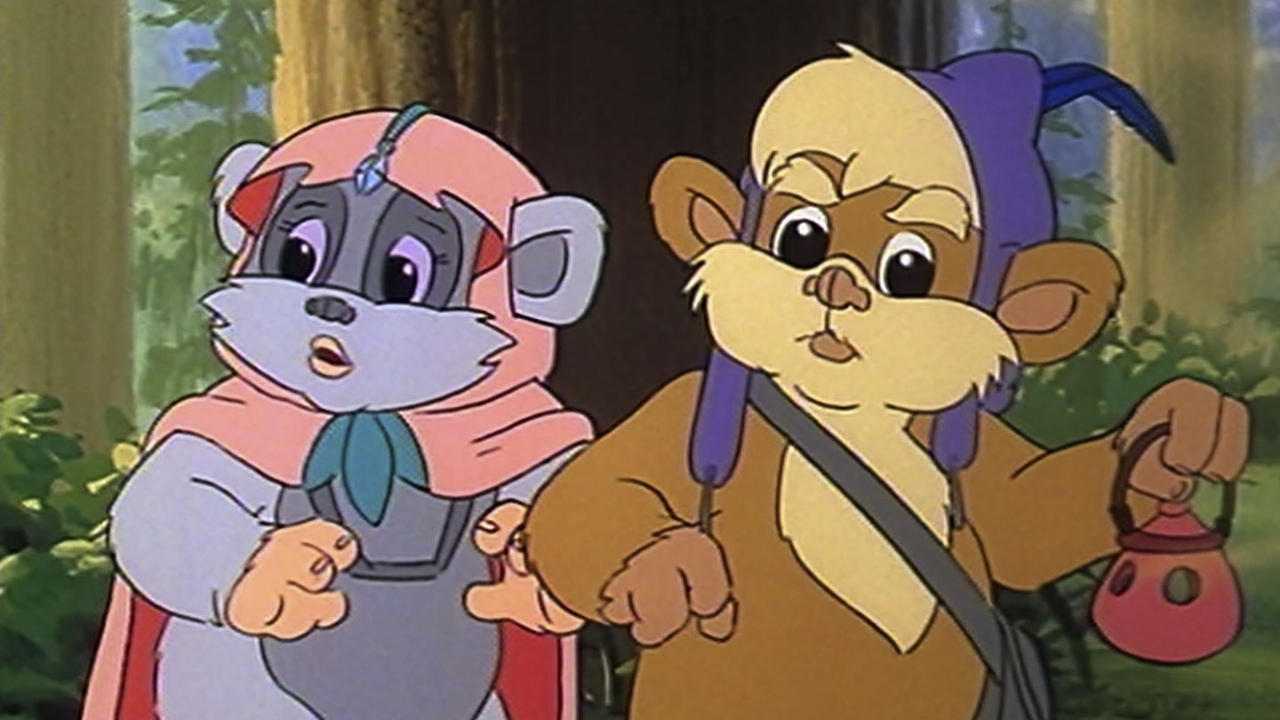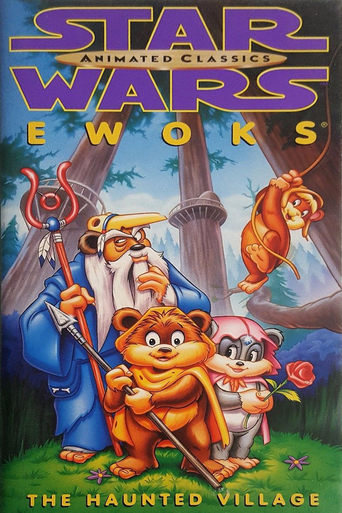Chip_douglas
Unlike the Droid series, which consists of three different story arcs, there is no thread binding any of the Ewok episodes together (despite a hardly noticeable change in seasons), or at least not enough to form the basis of a 'feature film'. Still, that is how "The Haunted Village" is marketed, a 'feature edition' with new music and a production credit for Rick McCallum (who also got a 'retcon' production credit on the original Star Wars trilogy merely by being involved with the special editions). It combines the only four episodes of the first (1985) series that can be considered to share a common theme, namely the battle between good Ewok shaman Logray and evil Tulga Witch Morag. But even so, it still feels like four short stories stuck together. In order to have the beginning of the 'movie' connect with the end, it begins with the back story about young Logray and Morag as told by Chief Chirpa from the start of episode 9, "Sunstar vs Shadowstone" then moves to the start of episode 2, appropriately called "The Haunted Village", followed by # 1 "The Cries of the Trees" and # 3 "Rampage of the Phlogs". Clumsily enough, when they get back to episode 9, the editors neglected to take out the references to Chirpa's story the previous night, creating a continuity slip up, for when taken as a one continues story, several nights have passed in between.All four stories feature Morag in a villainous role, though in the first three see remains mostly a manipulator pulling strings: first, in "The Haunted Village" she orders her flying slave the Mantigrue (a dragon not unlike Maleficent from Sleeping Beauty) to devour the Ewok's sun-berry trees. Logray uses soap made from the rare shadow-root plant to turn the sun-berry trees (more like bushes really) invisible before the flying beast returns, but the Ewok's smelly swamp dwelling cousins, the Duloks, mess up his plan by stealing the last bar. Next, during "The Cries of the Trees" Morag captures Queen Izrina (first seen in the Ewok adventure "Caravan of Courage") and turns her to evil, causing forest fires during what is already a period of drought. In "Rampage of the Phlogs" Morag takes a back seat as she fools a family of giant Phlogs (one of this species returned in altered form in the Clone Wars Micro Series Arena fight, episode 6) into thinking the Ewoks have kidnapped their enormous baby. Finally, in "Sunstar vs Shadowstone", Logray and Morag face off for the final time, with the fate of the powerful yin yang object of the title in the balance, after Logray's new apprentice Teebo and his friends walk straight into the witches claws.There are a great number of characters to keep track of during the course of these four short episodes alone, as the (first) series manages to include every Ewok introduced in Return of the Jedi (Wicket, Paploo, Teebo, Chief Chirpa and Logray), Caravan of Courage (Wickets parents, Deej and Shodu and brothers, Weechee and Willy) and several 'young reader' books that preceded it (which introduced Princess Kneesa and gave some of the Woklings their names, not to mention the Duloks and Phlogs). However, Logray looks the way he did in Caravan of Courage, not Return of the Jedi, and Paploo and Teebo seem to have changed roles (originally, Paploo (Kenny Baker) was smaller then butch Teebo (Jack Purvis), but in the cartoon it's the opposite). We also learn how all of them are related: Kneesa is Chirpa's daughter, which naturally (?) makes her a princess, the new authority figure and main foil Aunt Bozzie is Chirpa's sister and mother of Paploo. All of these character get their chance to shine in the first series, but in the second the cast was reduced to focus only on the main four: Wicket, Kneesa, Teebo and Latara. Also note that Teebo's little sister Malani has a crush on Wicket, and gets her headdress during the festival of Hoods in episode one. However, because this installment is shown second in this presentation, another continuity goof slips in as we see Malani wearing her hood long before receiving it.The Nelvana people, who are not always known for their consistent character animation really outdid themselves with some exquisite backgrounds, inventive pans and great character designs. It is obvious their style was better suited to drawing cute furry characters than the mechanicals and aliens from "Droids". The scenes where the Duloks and Woklings are covered in invisible paint being especially nice. Also, the overall cuteness of the cartoon (and the Ewoks in general) helps you forget about the strict rules concerning on screen violence the animators had to adhere to during the mid eighties. The new score by Marco D'Ambrosio is a bit of a dud, though, and frankly, unnecessary. It starts off way too sweet and soon becomes repetitive (especially whenever the Duloks appear). One scene at the start of the second story is especially sloppily executed, as Latara starts playing her flute while we are already hearing several on the soundtrack. To counter this, later on, Paploo is seen blowing his horn but no sound comes out. In the third part, Kneesa sings an Ewok lullaby, "Abi Wabi Wokling", which is unchanged from the original broadcast, ensuring that Taj & Inshira Mahal still get an on screen credit.7 out of 10

